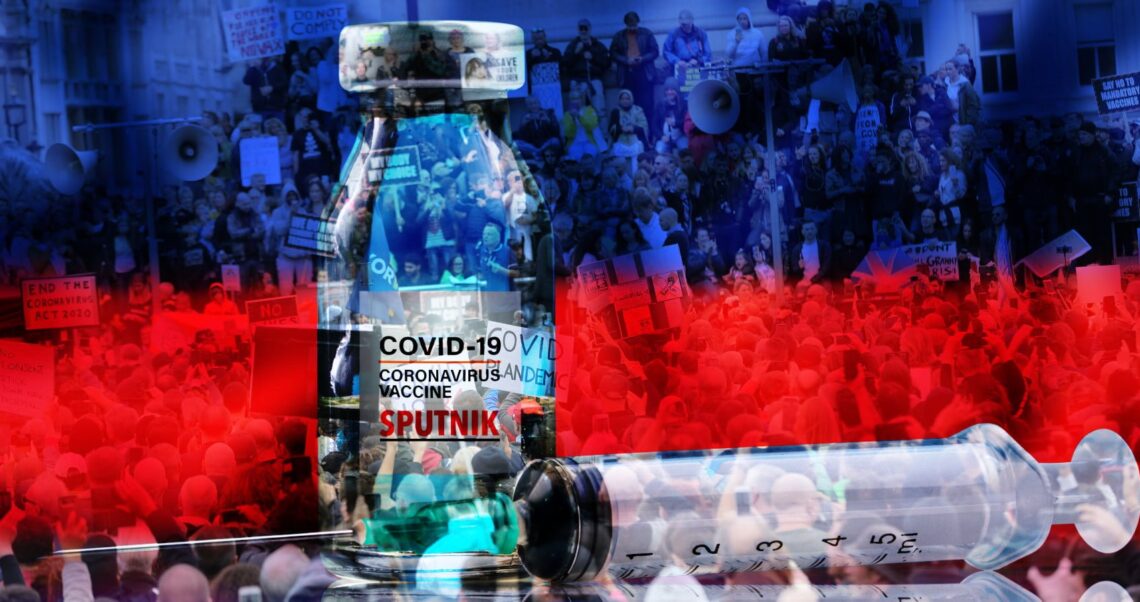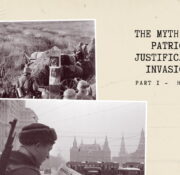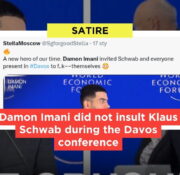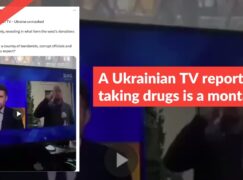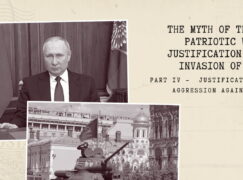Since the beginning of the war in Ukraine, there has been a trend in which anti-vaccine accounts have been changing their narrative towards supporting Kremlin propaganda. This phenomenon shows how strong Russian influence is. The following text gives an insight into how conspiracy groups, consciously or not, spread the disinformation generated in Moscow. Due to the lack of in-depth research in this area, we decided to produce a report in which we took a closer look at this issue, based on social media.
This research was conducted in cooperation with a group of volunteers, without whom the analysis of several hundred social media accounts would not be possible. We highly appreciate their hard work! The team led by the author of this report included the following people:
- Julia Dobrowolska,
- Szymon Kobylarz,
- Bartosz Kozak,
- Magdalena Kozłowska,
- Katarzyna Latoszek,
- Weronika Rezmer,
- Julia Tokarz.
Foreword
The invasion of Ukraine by the Russian army touched global public opinion to an unprecedented degree. In Poland, due to the geographic proximity of the conflict, the topic still evokes strong emotions. Such an unprecedented event also had an impact on the Internet conspiracy sphere. Instantly, narratives about the staged conflict or those justifying an attack on Ukraine began circulating throughout social media. Soon after, Polish social media was flooded with disinformation about the refugee crisis, which was supposed to evoke aversion to Ukrainians.
It was quickly noticed that the accounts that had so far spread disinformation in connection with the COVID-19 pandemic had a large share in the spread of conspiracy theories and false information. It was important information that confirmed the observations made so far. As we indicated in our report from March 2021, propandemic narratives (including anti-vaccine ones) were strongly associated with the Kremlin’s centres of influence.
An important thread is also the connection of the Polish extreme right with conspiratorial circles spreading pro-Kremlin narratives. The following research confirms what emerged from our Analysis conducted in August 2021: a large proportion of pro-Kremlin accounts spread or used to spread homophobic, anti-Semitic or anti-immigration narratives. You can read more about this issue in the FakeNews.pl report from April 2022.
The previously published PJATK report, created by a team of specialists researching disinformation in the Internet space, confirms that the anti-vaccine community spreads anti-Ukrainian narratives. In the aforementioned text, we find, first of all, an analysis of the activities of traditional conspiracy portals (websites). However, in its last segment, the activities of far-right politicians and prominent representatives of conspiracy circles in social media were presented. The PJATK report is therefore a very good supplement to the following research, which focuses primarily on less popular accounts.
Methodology of the report
Due to the limitations of the project, we decided to select only two social media platforms: Twitter and Facebook. The way in which these media platforms operate makes it relatively easy to search and identify disinformation content.
Instagram and TikTok are quite a challenge to analyse due to the type of content distributed (images and videos). By contrast, studying the Telegram messenger requires advanced content search tools and was beyond the scope of this report. A very interesting analysis of anti-refugee channels in Polish on this platform was carried out by the Digital Forensic Research Lab (DFRLab). We encourage you to read this material in order to deepen your knowledge.
Goal of the report
The goal of this report was primarily to determine what type of narratives have been duplicated by pro-Russian social media accounts in Polish since the outbreak of the war. Then we assessed what conspiracy content they had created before, with particular emphasis on propandemic disinformation. An additional outcome of the report was the percentage of profiles duplicating the Kremlin propaganda that had previously spread propandemic content, including anti-vaccine content. At this point, it is worth noting that the quantitative analysis is not comprehensive and should be treated as an introduction to further research and determination of general trends and tendencies. The team’s activities focused primarily on accounts that created disinformation content on their own by sharing it on their profiles in social media. They were the subject of a broader analysis. It should be noted, however, that all the accounts examined in this report replicated the Russian propaganda in one way or another, for example by commenting on Facebook posts or by posting content on Twitter without commenting.
Methodology description
To enable efficient analysis, the activities of our team took place in three steps:
- Step I – search and identification of accounts spreading pro-Kremlin propaganda – Searching for accounts on social media platforms was performed mainly with the use of key phrases. They had been identified by both the FakeNews.pl team and specialists from the Polish-Japanese Academy of Information Technology. In addition, conspiracy groups on Facebook and comment sections of popular conspiracy activists on both platforms were researched as well.
- Step II – Identification of accounts subject to full analysis – In order for an account to be fully analysed, it had to meet two (in the case of Twitter, three) prerequisites: it had to have a minimum of 10 followers (Twitter), spread content consistent with Russian propaganda regarding the war, through self-created posts in social media, and create at least three such posts since 24/02/2022. They were identified by the following narratives:
- Justifying the Russian invasion of Ukraine;
- Evoking aversion to refugees staying in Poland;
- Building a negative image of Ukraine;
- Undermining sanctions and disrupting the unity of states opposing the invasion;
- Blaming the West for the outbreak of the war;
- Insinuating that the entire conflict has been staged.
- Step III – analysis of accounts spreading pro-Kremlin propaganda – After identifying an account that met the above criteria, we conducted a thorough analysis. We searched for and collected 3 posts spreading content consistent with Russian propaganda about the war. We then checked whether the account had spread propandemic (including anti-vaccine) disinformation in the past. If so, then we also saved three posts of this type in our database. The last stage of the analysis was to determine whether a given profile generated other conspiracy content. Analysed topics included disinformation related to: medicine, LGBT+ community, climate change, migration, 5G, Jews, and international conspiracies of globalists. This was to assess whether a particular account has been involved in conspiracy for a longer period of time.
Finally, it is worth noting that due to limitations in the possibilities of quantitative analysis, the following text should not be treated as a comprehensive form of research on this phenomenon. It does, however, provide an up-to-date and broad overview of narratives spread.
Disinformation narratives regarding the war
Regardless of the social media platform, disinformation is built around the same content. The narratives spread by conspiracy accounts are largely duplicated and cover the same areas. Below we present selected content shared by 212 accounts that have been fully analysed by us. The team of volunteers collected posts from individual accounts by taking screenshots of relevant content. Thanks to this, we were able to, among other things, archive the activity of several accounts that since then have been blocked or deleted.
In this section, we present the disinformation narratives about the war in Ukraine. From the moment the first Russian tanks crossed the border, the Moscow-led propaganda apparatus immediately began a full-blown campaign. The number of narratives aimed at Ukraine is huge. EUvsDisinfo has catalogued (as of August 2022) over 5,500 individual cases of disinformation aimed at the invaded country. The narratives presented below are only a fraction of the anti-Ukrainian propaganda, but they were the dominant topics in Poland.
1. Anti-refugee rhetoric
The anti-refugee rhetoric is the dominant message spread by Polish disinformation circles in connection with the war. It is intended to evoke hostility towards Ukrainians fleeing the invasion. It is particularly desired by Russian influence centres, as it has a negative impact on empathy and the willingness to help not only refugees but also Ukraine as such. It is also intended to create divisions and antagonisms within Polish society, which, when preoccupied with internal problems, will not pay attention to the situation of the neighbour. Below we present a group of posts from Twitter and Facebook duplicating very popular narratives:
- Ukrainians are more privileged than Poles who become second-class citizens in their own country;
- PESEL gives Ukrainians full civic rights in Poland;
- Ukrainians take hospital beds and there is not enough of such places for Polish citizens;
- Polish children are discriminated against in schools because refugees from Ukraine are favoured;
- Flats intended for Polish families are handed over to Ukrainians;
- Ukrainians are very demanding towards Poles;
- the war is profitable for Ukrainians, and Poles suffer losses because of it;
- Poland is in the process of “Ukrainization” and the destruction of national identity;
- refugees pose an epidemic threat;
- Ukrainians pose a threat to the safety of Poles;
- there are few women with children among refugees, and the border is mostly crossed by black people.

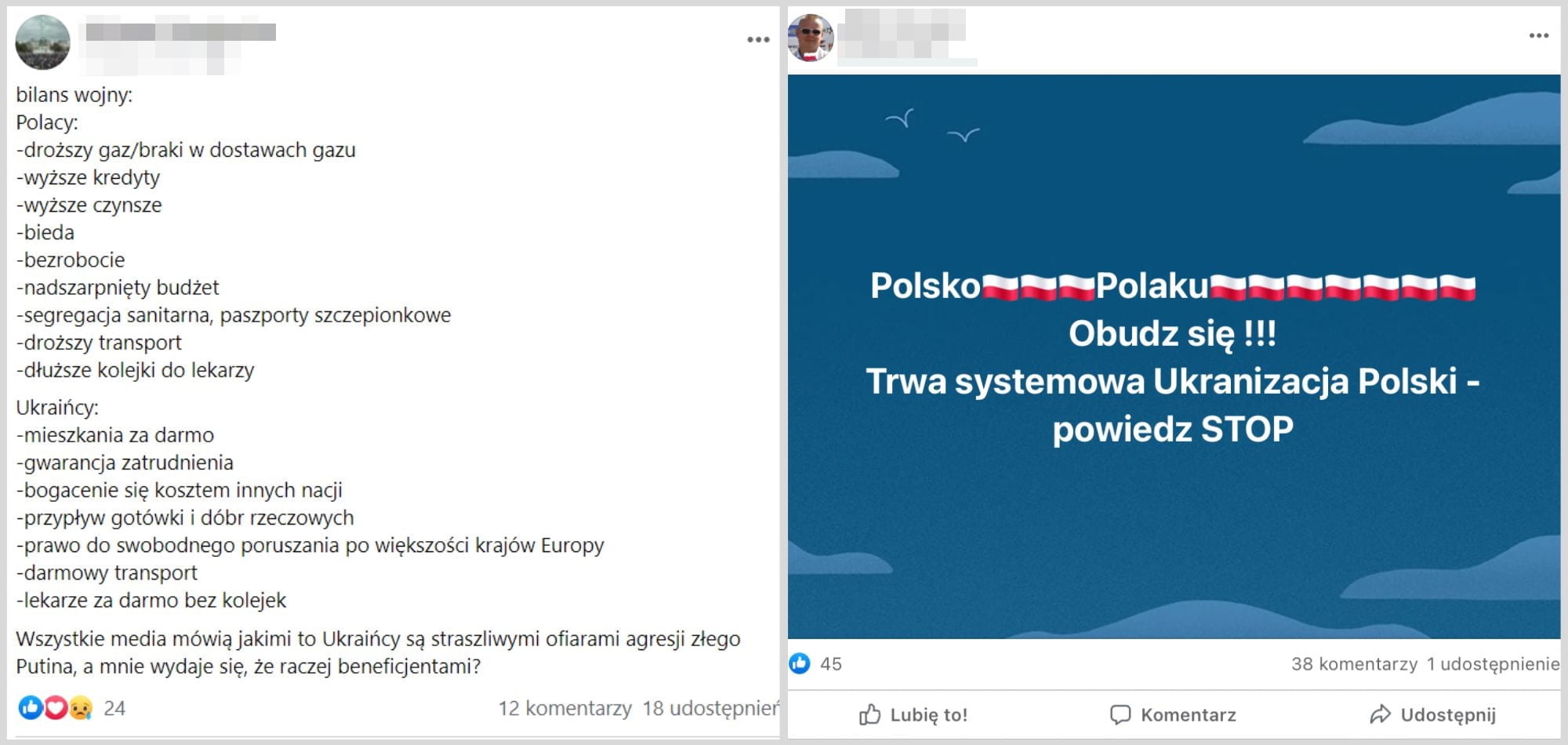
2. Portraying Ukraine as a mainstay of the cult of Bandera
Another type of narrative are those that are strictly anti-Ukrainian. Their goal is to cause aversion to the defending country. Such content is to influence Poles in such a way to discourage them from both humanitarian and military aid.Their main purpose is to arouse fear and show Ukraine as a dangerous and Nazi-filled country.
The main method is to use historical animosities for this purpose, especially the Volhynian massacre. Extreme groups operating beyond our eastern border, mainly related to Ukrainian nationalism, are also presented as a threat. Their activities and influence on the situation are significantly exaggerated in order to arouse fear. Among this content, we can distinguish the following narratives:
- Ukraine supports Banderism, that is, Nazism;
- Ukraine is a totalitarian state;
- arousing animosity based on historical events (the Volhynian massacre);
- child trafficking and prostitution are flourishing in Ukraine;
- Ukraine is carrying out genocide in Donbas;
- Ukraine is a corrupt country and its authorities are incompetent.
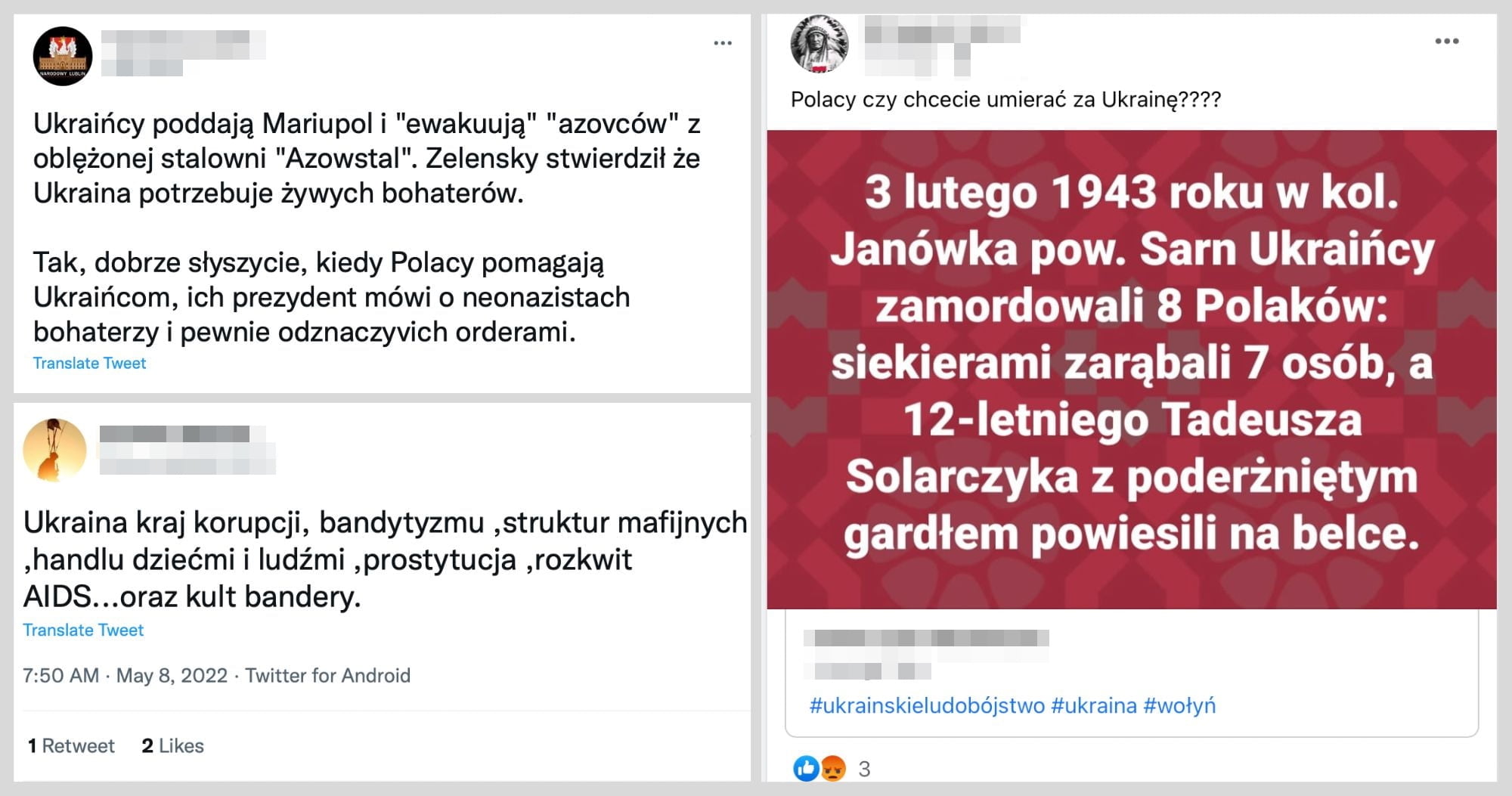
3. Justifying the invasion
Narratives supporting or justifying the Russian invasion are quite common, although much rarer than the ones described above. They are intended to warm the image of Russia and show that the war is waged for a good purpose. They present Ukraine as a threat to its neighbours and provoking the war itself, and Putin as the one who acted in self-defence. Among them, the following content can be distinguished:
- Putin saves Ukrainian children;
- Ukraine is not a real country, so it should be absorbed by its neighbours;
- Putin cleanses Ukraine of Nazis or Jews;
- Russia only attacks military targets;
- Putin defends “traditional values”;
- Ukrainians commit war crimes;
- The genocide in Bucha is a Ukrainian staging;
- Russia was provoked by Ukraine.
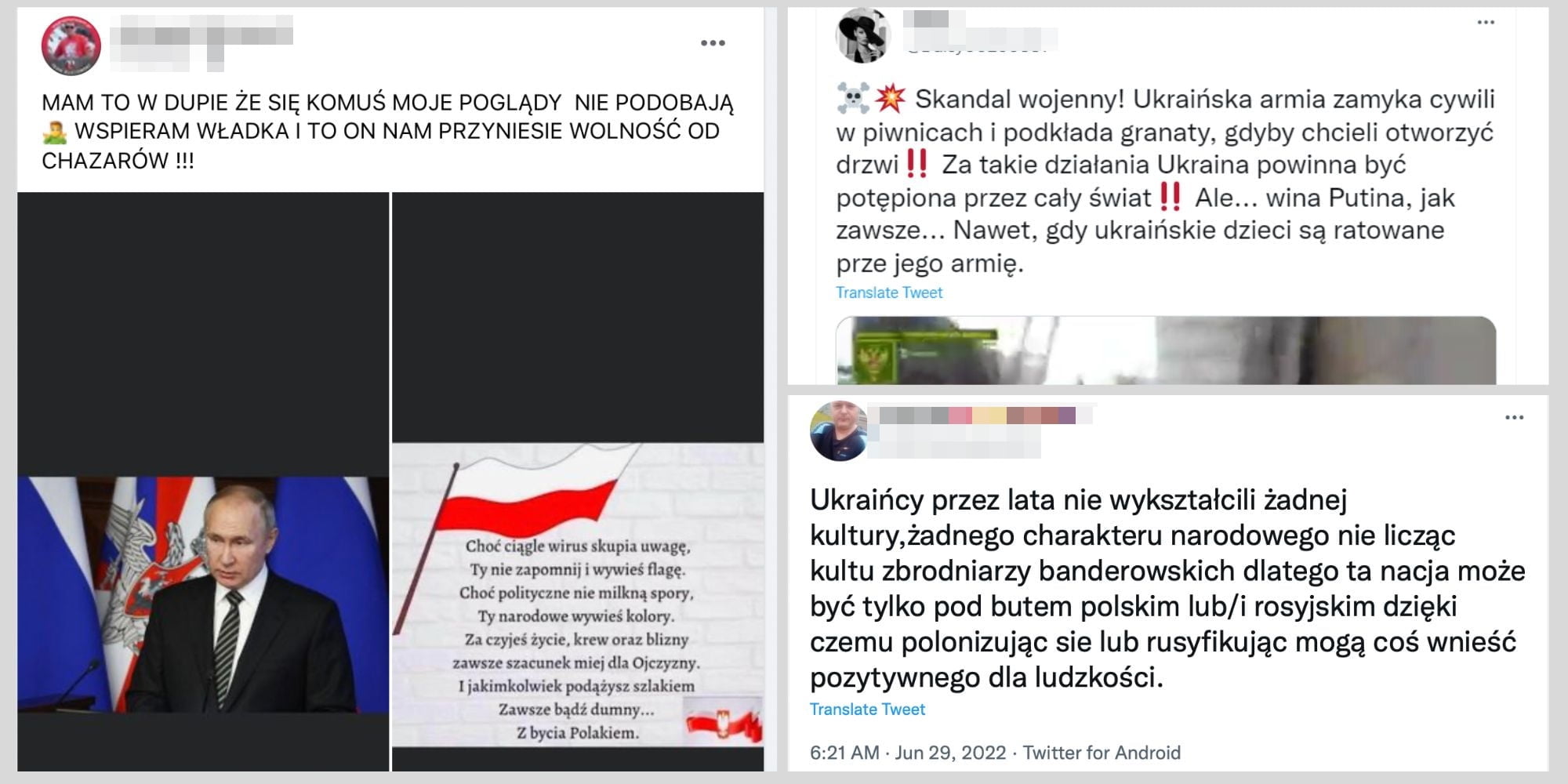
4. Undermining sanctions and blaming the West for the conflict
In addition to generating social antagonisms and aversion to Ukraine, Russian propaganda also focuses on undermining the unity of Western societies. The purpose of these narratives is to create public pressure that will lead to the ease of the sanctions. It is also about making the impression that it was NATO that incited Ukraine to war and posed a threat to Russia, so the invasion was only an act of self-defence. Among them, the following topics can be distinguished:
- the war is waged by NATO with the hands of Ukrainians;
- military aid provided to Ukraine only escalates the conflict;
- sanctions are ineffective and only hit Western societies;
- Westerners will die of hypothermia and starvation during the winter;
- Western involvement can lead to an extension of the conflict and nuclear war.

5. The conflict is nothing but a staging prepared by external forces
The narratives of the most conspiratorial nature are those that undermine the intensity of the war and even consider the entire invasion a hoax. It’s hard to say whether these narratives are desired by Kremlin propaganda. The exception is the conspiracy theory about laboratories in Ukraine producing biological weapons. It is a direct justification of the Russian aggression and was distributed by the media connected with Moscow and the power centres in the Kremlin.
The remaining content is an expression of a general distrust of conspiracy circles to any official information. What is worth noting is the prominent role of anti-Semitism. Narratives that can be distinguished in this area:
- There is a network of secret laboratories producing biological weapons in Ukraine;
- the purpose of the war is to establish the Heavenly Jerusalem;
- globalists under the disguise of the war create the WHO anti-pandemic treaty.
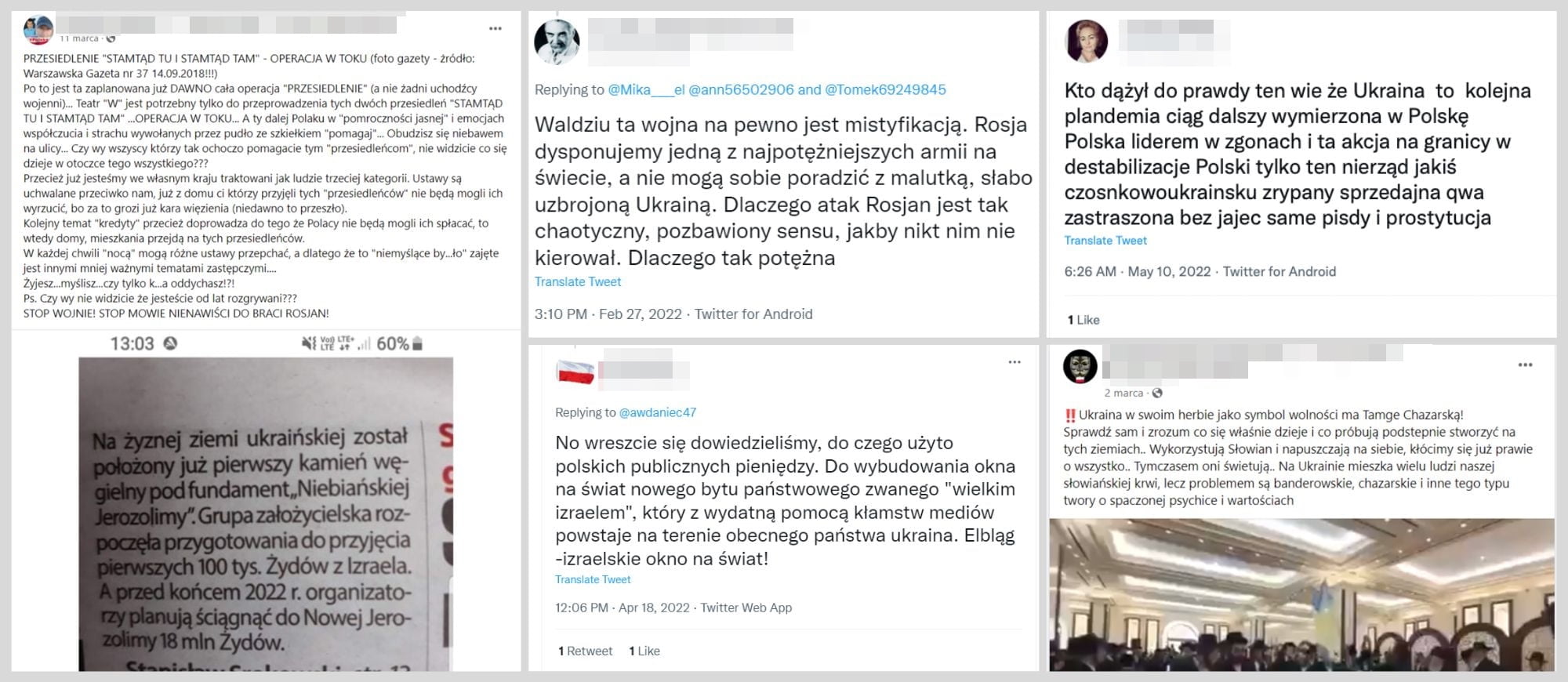
Propandemic narratives
Below we present examples of the content reproduced by the analysed accounts regarding vaccinations and the pandemic. The conspiratorial community very quickly picked up the topic of COVID-19, and with each successive month of the health crisis, it was gaining more and more supporters. Of the 212 accounts we examined more thoroughly, 161 profiles (75.9%) spread disinformation about the pandemic. As it turns out, much of the disinformation related to the SARS-CoV-2 virus was related to the Kremlin, as we wrote about in our report.
Anti-vaccine narratives
The explosion of anti-vaccine content took place when the first vaccines were introduced in December 2020. However, the first narratives of this type had appeared before and were related to the first research on vaccination. They were intended to undermine the legitimacy of the vaccination, and above all its safety.
Aggressive rhetoric tried to undermine trust in doctors and medicine, and indirectly undermined the achievements of Western scientists.According to a report by the European External Action Service, Russia and China’s propaganda centres were responsible for much of the disinformation related to the COVID-19 vaccines. In the course of research for this report, we distinguished the following anti-vaccine narratives:
- vaccination against COVID-19 causes multiple VAEs;
- COVID-19 vaccination contributes to infertility;
- vaccination against COVID-19 is intended to lead to depopulation;
- vaccinations against COVID-19 is a means to control humanity;
- vaccinations against COVID-19 are intended only to provide profits to pharmaceutical companies;
- vaccination against COVID-19 is a medical experiment;
- COVID-19 vaccines contain graphene;
- the majority of people who die from COVID-19 are vaccinated;
- spike protein found in vaccines is dangerous;
- vaccinated people are “super carriers”.
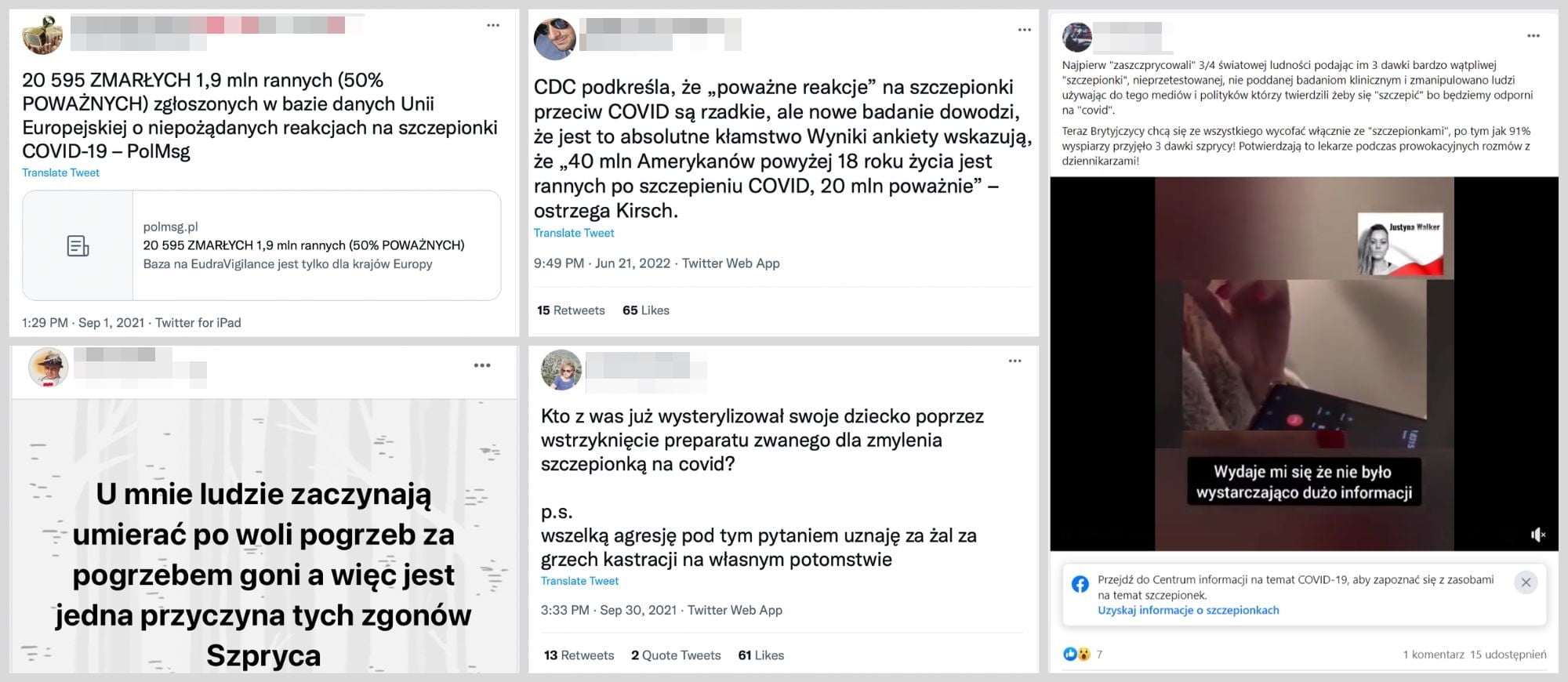
Other propandemic content
Before and after the introduction of vaccines, conspiracy circles spread misinformation about the actions taken in relation to the pandemic. The sense of using masks or introducing lockdowns was questioned. Narratives that can be distinguished in this area:
- Undermining the introduction of lockdowns;
- governments introduce sanitary segregation;
- Masks are ineffective and dangerous to health;
- The coronavirus is nothing but ordinary flu and does not pose a threat;
- SARS-CoV-2 tests are ineffective, and governments are manipulating data about infections;
- The pandemic has been planned;
- Hospitals are empty because there is no pandemic;
- Amantadine is an effective drug for COVID-19;
- Ivermectin is an effective drug for COVID-19;
- Hydroxychloroquine is an effective drug for COVID-19;

Conspiracy narratives
The last segment of the narratives analysed by us were broadly understood conspiracy theories. According to our research, such content was generated by as many as 127 profiles (59.9%) on both platforms. They enjoyed considerable popularity. People who share this type of content usually look for the meaning in the modern world and try to simplify the very complex mechanisms that take place around them.
Conspiracy theories are also an effective method of radicalising vulnerable individuals and deepening polarisation. The narratives in this area were related to many different topics, including:
- The harmfulness of 5G;
- Undermining global warming;
- LGBT+ lobby destroying “traditional values” and family;
- Anti-immigration content, including the “Great Replacement” hypothesis;
- New World Order (NWO);
- conspiracies related to QAnon, Jews and globalists.

Statistics
This section covers the quantitative analysis of the analysed accounts. It should be treated as an additional element of this report, which shows certain trends and tendencies, but is not an unambiguous, statistical solution to this issue. Our team has managed to identify 333 accounts responsible for spreading pro-Kremlin propaganda. Out of them, 212 accounts met the criteria presented in the methodology and were subjected to a more detailed analysis. The remaining profiles have undergone a general review, and information related to those is be presented only in numerical form.
Disinformation on Twitter
As in the case of any other social media medium, the conspiracy community has a strong representation on Twitter. We thoroughly analysed 129 out of 174 identified accounts spreading pro-Russian propaganda. We only considered accounts with 10 or more followers that met the prerequisites of the methodology. We were mainly interested in profiles of anonymous users, not those kept by prominent representatives of conspiracy movements. However, they were not completely absent and we have conducted an in-depth analysis of profiles run by Paweł Wyrzykowski, Piotr Wielgucki or Piotr Szlachtowicz.
Numbers on Twitter
129 identified profiles met the criteria of the full analysis presented in the methodology. This means that those accounts created at least 3 posts containing elements of pro-Russian propaganda about the war. Of these, 27 accounts (20.9%) shared only pro-Kremlin content. It is worth noting, however, that 11 of them were created in 2022, and 8 in February or later. This means that they could have been used as deliberate sources spreading the pro-Russian narratives. Therefore, they did not have time to cover the propandemic content that had peaked in the period of 2020-2021.
Among the analysed profiles, 21 (16.3%) shared both pro-Russian and propandemic content. However, as many as 81 accounts (62.8%) conducted full conspiracy activities, spreading not only the Kremlin propaganda or propandemic disinformation, but also other conspiracy theories such as 5G, depreciation of global warming or alleged actions of globalists. The numerical results of the analysis are presented in the chart below.
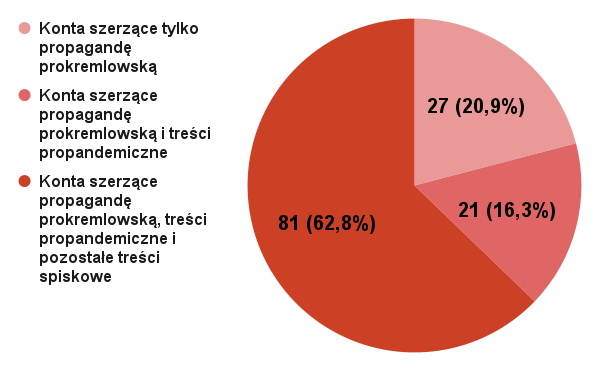
The above statistics indicate that the majority of the analysed profiles spreading Russian propaganda on Twitter (79.1% in total) had previously shared propandemic content.
Disinformation on Facebook
Facebook remains the most popular social networking platform in Poland, with approximately 27 million active users. This obviously means that disinformation is spreading extremely fast there with huge exposure. We identified 159 accounts spreading Russian propaganda, 83 of which met the prerequisites of the methodology for full analysis. Once again, we focused on anonymous users, who are not necessarily more widely known in the conspiracy community, although there were also people with greater reach among the analysed profiles.
Numbers on Facebook
Of the 83 analysed Facebook profiles, 24 (28.9%) only replicated Russian propaganda about the war. This means that they created at least 3 posts spreading these narratives on their own, but did not generate other conspiracy content. Due to Facebook’s limitations in displaying creation dates for individual accounts, we were not able to clearly determine how many of them were created in 2022.
13 users (15.7%) created content on their walls that spread both pro-Russian and propandemic narratives. The remaining 48 profiles (55.4%) created posts on all three conspiracy topics. The chart below presents the identified narrative distribution on Facebook.
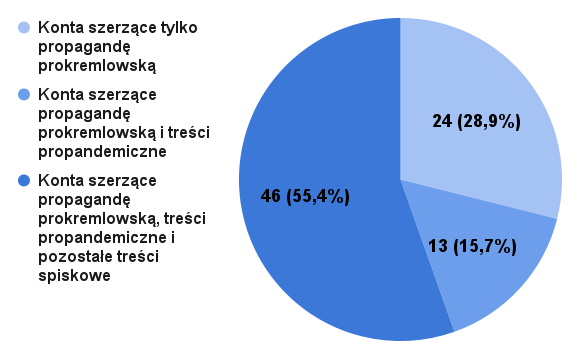
Similarly to Twitter, most of the profiles (71.1% in total) that replicated propandemic narratives currently create content in line with Russian propaganda.
The remaining accounts
Accounts that did not meet the prerequisites for full analysis (i.e. did not create at least 3 independent pro-Russian posts) were also analysed. We assessed what content was shared or commented on by them. On this basis, we collected data on the type of conspiracy narratives and their numbers. There were a total of 121 accounts (36.3% of all profiles) analysed in this section, both from Facebook and Twitter.
Of these, 30 (24.8%) only shared pro-Russian propaganda about the invasion of Ukraine. 23 profiles (19%) also spread propandemic disinformation in addition to the Kremlin content. Finally, 68 users (56.2%) continued to share the full spectrum of conspiracy theories and disinformation narratives. The summary can be seen in the chart below.
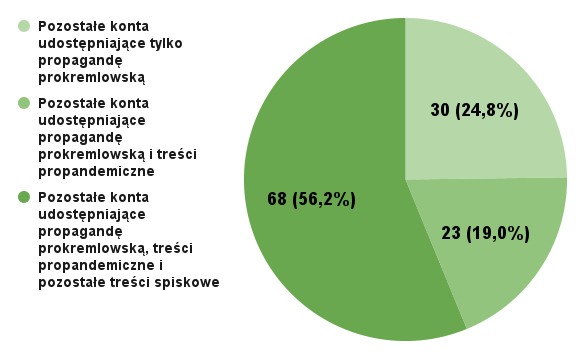
In this case, as in the previous ones, the dominant part (75.2% in total) are profiles that shared both Russian propaganda and propandemic disinformation.
Statistics summary
It is clear from the statistics provided that most of the accounts that share Kremlin propaganda are the same social media users who spread propandemic disinformation and other forms of conspiracy narratives. Out of 212 profiles from Twitter and Facebook we thoroughly analysed, 161 (75.9%) showed the above dependence. Below is a summary of the statistics from both social media platforms.

After taking into consideration the profiles that did not meet the prerequisites for full analysis, the statistics remain almost identical. Out of a total of 333 accounts collected by us, 252 (75.7%) spread both Russian propaganda and other conspiracy content, including propandemic disinformation. The chart below provides a complete summary of the results of our work.
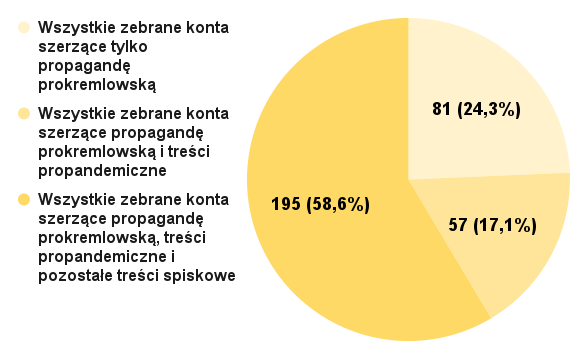
The above statistics show a trend that we could observe from the beginning of the war. A large part of the profiles previously spreading propandemic disinformation very quickly switched to sharing pro-Kremlin propaganda. Although the quantitative analysis in this report is incomplete, it is in line with the observations of a team of specialists from the Polish-Japanese Academy of Information Technology and the quantitative analysis of the Institute for Internet and Social Media Research (Instytut Badań Internetu i Mediów Społecznościowych, IBIMS).
Summary
In times of enormous and even overwhelming access to information, it is especially easy to spread disinformation in social media. Due to the ongoing infodemic, it is becoming increasingly difficult to distinguish between credible and false information. Propaganda centres of authoritarian and totalitarian states play a special role in this. Driven by their particular interests, they generate such content to wreak havoc and undermine the foundations of democracy, to be able to fulfil their imperialist ambitions more easily.
In our region, the Russian Federation is the undisputed leader in spreading disinformation. Due to the outbreak of the war, its activities became even more intensive. Every day, dozens of pieces of unverified information created by propagandists from the Kremlin reach our country.
Kremlin disinformation in Poland
Polish conspiracy circles are in the centre of Russian disinformation. In addition to creating their own content, they happily share stories generated in Moscow. Their activity in social media is dynamic and the reach is huge. Accounts that had so far generated disinformation about the pandemic and vaccines with great verve quickly shifted to anti-refugee, pro-Russian and anti-Ukrainian narratives.
The observations in this report validate this trend, which is in line with previous research, as well as EUvsDisinfo’s database. This means that the Kremlin’s influence operations are highly effective, and the conspiratorial community largely uses the same sources, without trying to verify the information on a larger scale.
However, this report is not able to determine how many of the analysed profiles share Russian propaganda deliberately, although the awareness of this problem in the society has increased significantly since the outbreak of the war.
Further research
In addition to the accounts analysed for this report, there are thousands of similar accounts online. They are not only on Facebook and Twitter, but also on TikTok, Telegram and Instagram. Subsequent analyses show what threats are invented by conspiracy circles and why this issue requires constant monitoring as well as conducting educational campaigns and combating disinformation. We hope that the data presented in this report will be important and useful for further analysis and research.
Sources:
EUvsDisinfo: https://euvsdisinfo.eu/eeas-special-report-update-short-assessment-of-narratives-and-disinformation-around-the-covid-19-pandemic-update-december-2020-april-2021/ oraz https://euvsdisinfo.eu/ukraine/
